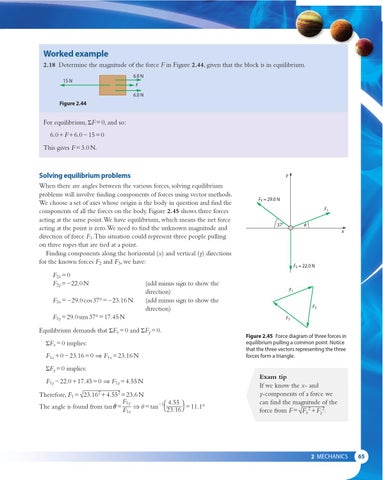Worked example 2.18 Determine the magnitude of the force F in Figure 2.44, given that the block is in equilibrium. 15 N
6.0 N F 6.0 N
Figure 2.44
For equilibrium, F = 0, and so: 6.0 + F + 6.0 − 15 = 0 This gives F = 3.0 N.
Solving equilibrium problems
y
When there are angles between the various forces, solving equilibrium problems will involve finding components of forces using vector methods. We choose a set of axes whose origin is the body in question and find the components of all the forces on the body. Figure 2.45 shows three forces acting at the same point. We have equilibrium, which means the net force acting at the point is zero. We need to find the unknown magnitude and direction of force F1. This situation could represent three people pulling on three ropes that are tied at a point. y Finding components along the horizontal (x) and vertical (y) directions for the known forces F2 and F3, we have: F2x = 0 F2y = −22.0 N F3x = −29.0 cos 37° = −23.16 N
F1 θ
37°
x
F
F2 = 22.0 N
F3 = 29.0 N
(add minus sign to show the direction) 37° to showθ the (add minus sign direction)
F3y = 29.0 sins 37° = 17.45 N
F1 F1 x
F2 F3
Equilibrium demands that Fx = 0 and Fy = 0. Fx = 0 implies:
F3 = 29.0 N
F2 = 22.0 N
F1x + 0 − 23.16 = 0 ⇒ F1x = 23.16 N
Figure 2.45 Force diagram of three forces in equilibrium pulling a common point. Notice that the three vectors representing the three forces form a triangle.
Fy = 0 implies: F1y − 22.0 + 17.45 = 0 ⇒ F1y = 4.55 N Therefore, F1 = 23.162 + 4.552 = 23.6 N F1y 4.55 The angle is found from tan = ⇒ = tan−1 = 11.1° 23.16 F1x
Exam tip If we know the x- and y-components of a force we can find the magnitude of the force from F = Fx2 + Fy2.
2 MECHANICS
65
